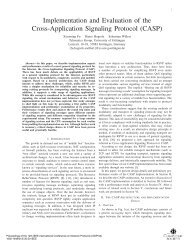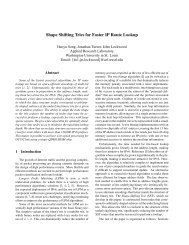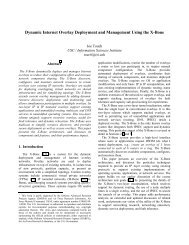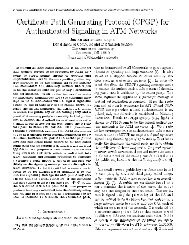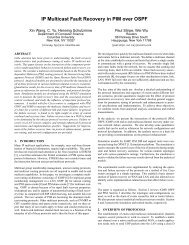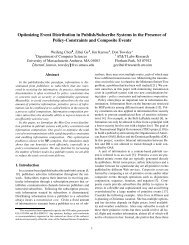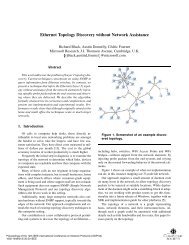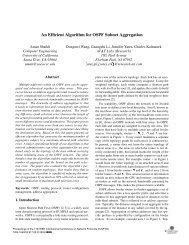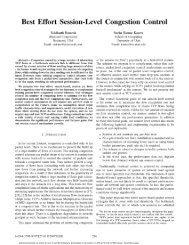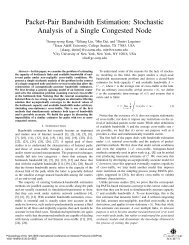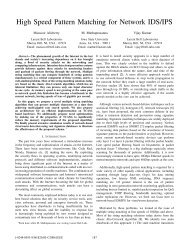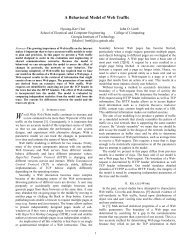Coordinated Network Scheduling: A Framework for End-to ... - ICNP
Coordinated Network Scheduling: A Framework for End-to ... - ICNP
Coordinated Network Scheduling: A Framework for End-to ... - ICNP
Create successful ePaper yourself
Turn your PDF publications into a flip-book with our unique Google optimized e-Paper software.
<strong>Coordinated</strong> <strong>Network</strong> <strong>Scheduling</strong>:<br />
A <strong>Framework</strong> <strong>for</strong> <strong>End</strong>-<strong>to</strong>-<strong>End</strong> Services<br />
Chengzhi Li Edward W. Knightly<br />
Department of Electrical and Computer Engineering<br />
Rice University<br />
Abstract<br />
In multi-hop networks, packet schedulers at downstream<br />
nodes have an opportunity <strong>to</strong> make up <strong>for</strong> excessive latencies<br />
due <strong>to</strong> congestion at upstream nodes. Similarly, when<br />
packets incur low delays at upstream nodes, downstream<br />
nodes can reduce priority and schedule other packets first.<br />
The goal of this paper is <strong>to</strong> define a framework <strong>for</strong> design<br />
and analysis of <strong>Coordinated</strong> <strong>Network</strong> <strong>Scheduling</strong> (CNS)<br />
which exploit such inter-node coordination. We first provide<br />
a general CNS definition which enables us <strong>to</strong> classify<br />
a number of schedulers from the literature including,<br />
FIFO+, CEDF, and work-conserving CJVC as examples of<br />
CNS schedulers. We then develop a distributed theory of<br />
traffic envelopes which enables us <strong>to</strong> derive end-<strong>to</strong>-end statistical<br />
admission control conditions <strong>for</strong> CNS schedulers.<br />
We show that CNS schedulers are able <strong>to</strong> limit traffic dis<strong>to</strong>rtion<br />
<strong>to</strong> within a narrow range resulting in improved end<strong>to</strong>-end<br />
per<strong>for</strong>mance and more efficient resource utilization.<br />
1 Introduction<br />
During periods of congestion, a flow or class’ end-<strong>to</strong>end<br />
per<strong>for</strong>mance properties are strongly influenced by<br />
the choice of the packet scheduling algorithm employed<br />
at the network’s routers. Consequently, recent advances<br />
in scheduler design can ensure properties such as fairness,<br />
per<strong>for</strong>mance differentiation, and per<strong>for</strong>mance isolation<br />
[3, 13, 15, 25]. Moreover, such per<strong>for</strong>mance properties<br />
are now achievable in high speed implementations<br />
[23, 28, 30] and scalable architectures in which core nodes<br />
do not maintain per-flow state [6, 24, 31].<br />
Exploiting these scheduling mechanisms, admission<br />
control can limit congestion levels so that (<strong>for</strong> example)<br />
targeted latencies and throughputs are ensured, thereby<br />
providing services with predictable and controlled per<strong>for</strong>mance<br />
levels [21]. For example, statistical class-based admission<br />
control tests have been derived <strong>for</strong> Earliest Deadline<br />
First [4, 26, 29], Weighted Fair Queueing [12, 26, 36],<br />
Strict Priority [26], and Virtual Clock [19]. Moreover,<br />
techniques <strong>for</strong> providing multi-node or end-<strong>to</strong>-end statistical<br />
services have been developed <strong>for</strong> several classes of<br />
non-work-conserving schedulers [5, 27, 29, 35] and <strong>for</strong><br />
Weighted Fair Queueing [36].<br />
However, in both the data plane (scheduling) and control<br />
plane (admission control), none of the a<strong>for</strong>ementioned<br />
techniques exploit a key property of multihop networks,<br />
namely, that a downstream node can compensate <strong>for</strong> excessive<br />
latency or unfairness incurred at an upstream node.<br />
Nor will downstream nodes reduce the priority of a packet<br />
which arrives ahead of schedule due <strong>to</strong> a lack of congestion<br />
upstream. In contrast, a number of service disciplines<br />
in the literature have been proposed which do exploit this<br />
property, which we refer <strong>to</strong> as coordination. Examples include<br />
the old cus<strong>to</strong>mer first service discipline [8], global<br />
earliest deadline first (G-EDF) [8], modified first-in-firs<strong>to</strong>ut<br />
(FIFO+) [10], and coordinated earliest-deadline-first<br />
(CEDF) [1, 2].<br />
The contributions of this paper are twofold. First, we<br />
devise a general framework <strong>for</strong> design and specification of<br />
a class of service disciplines which we refer <strong>to</strong> as <strong>Coordinated</strong><br />
<strong>Network</strong> <strong>Scheduling</strong>s (CNS). The key CNS property<br />
is that a packet’s priority index at a downstream node<br />
is recursively expressed through the priority index of the<br />
same packet at the previous node, and there<strong>for</strong>e is a function<br />
of the packet’s (perhaps virtual) entrance time in<strong>to</strong><br />
the network. We show that a broad class of schedulers<br />
from the literature, including CEDF, FIFO+, and others,<br />
can be characterized by this recursion and belong <strong>to</strong> the<br />
CNS class. We make several observations regarding coordinated<br />
network schedulers. (1) They can be core-stateless,<br />
in some cases quite trivially, and there<strong>for</strong>e can share the<br />
same scalability properties of architectures in which core<br />
nodes do not maintain per-flow state [31]. (2) The well<br />
known traffic dis<strong>to</strong>rtion problem, in which provisioning of<br />
end-<strong>to</strong>-end services is hampered by complex traffic dis<strong>to</strong>rtions<br />
due <strong>to</strong> multiplexing, e.g., [11, 22], can be avoided all<br />
<strong>to</strong>gether. (3) CNS inter-server cooperation can improve a<br />
flow’s end-<strong>to</strong>-end per<strong>for</strong>mance, and consequently, improve<br />
the efficiency and utilization of the network at large.<br />
Our second contribution is <strong>to</strong> devise a general theory<br />
<strong>for</strong> statistical analysis and admission control of coordi-<br />
1
nated servers. Our key technique is <strong>to</strong> devise a framework<br />
<strong>for</strong> end-<strong>to</strong>-end service provisioning that exploits the<br />
structural properties of coordinated network schedulers,<br />
thereby overcoming the traffic dis<strong>to</strong>rtion problem and realizing<br />
the efficiency gains of coordination. To analyze<br />
CNS networks, we introduce the concept of essential traffic,<br />
which is the traffic that must be served be<strong>for</strong>e a time<br />
instant such that no local service violations will occur at<br />
that time. Using this concept and building on the interclass<br />
theory of [26], we derive expressions <strong>for</strong> the essential<br />
traffic and service envelopes, which provide a general statistical<br />
characterization of a CNS node’s workload and service<br />
capacity. Within this framework, we establish an important<br />
property of the CNS discipline, namely, that traffic<br />
dis<strong>to</strong>rtions in CNS networks are limited <strong>to</strong> within a narrow<br />
range. There<strong>for</strong>e, the essential traffic and service envelopes<br />
at a CNS node can be evaluated as simple and<br />
minimally dis<strong>to</strong>rted functions of the flows’ original (undis<strong>to</strong>rted)<br />
traffic envelopes that characterized traffic be<strong>for</strong>e entrance<br />
in<strong>to</strong> the network. We then derive CNS admission<br />
control conditions by trans<strong>for</strong>ming the problem of evaluating<br />
the service-violation probability in<strong>to</strong> the problem of<br />
computing the essential traffic envelope and the essential<br />
service envelope.<br />
Previous techniques <strong>for</strong> multi-node admission control<br />
include studies of non-work-conserving schedulers which<br />
shape and reshape traffic [5, 14, 16, 17, 27, 29, 34, 35].<br />
While such schemes can have good per<strong>for</strong>mance properties,<br />
they require per-flow traffic processing in core nodes<br />
and do not exploit the coordination property. For workconserving<br />
service disciplines, a key issue is traffic dis<strong>to</strong>rtion.<br />
Previous approaches include bounding this dis<strong>to</strong>rtion<br />
[7, 11, 22, 33] and exploiting isolation properties of<br />
GPS servers [18, 25, 36]. While such techniques are important<br />
<strong>for</strong> their generality, we will show that they can be<br />
conservative in practice. In contrast, our work develops<br />
a general framework <strong>for</strong> end-<strong>to</strong>-end services in CNS networks.<br />
Our solution applies <strong>to</strong> the broad class of (workconserving)<br />
CNS servers, exploits the efficiency gains of<br />
coordination, and provides an end-<strong>to</strong>-end admission control<br />
algorithm that is quite general and achieves high utilization<br />
<strong>for</strong> multi-class multi-node services.<br />
The remainder of this paper is organized as follows. In<br />
Section , we define the CNS discipline and show how<br />
scheduling algorithms from the literature can be classified<br />
within the CNS framework. Next, in Section ¡ we develop<br />
a general theory <strong>for</strong> analysis and admission control <strong>for</strong> statistical<br />
end-<strong>to</strong>-end services. Finally, in Section ¢ , we provide<br />
numerical admission control results, and in Section £<br />
we conclude.<br />
2 <strong>Framework</strong> <strong>for</strong> <strong>Coordinated</strong><br />
<strong>Scheduling</strong><br />
In this section, we provide a <strong>for</strong>mal definition of the CNS<br />
coordination property. We then use this definition <strong>to</strong> show<br />
how a number of schedulers from the literature possess this<br />
property so that our admission control tests derived in Section<br />
3 apply <strong>to</strong> a broad class of schedulers.<br />
2.1 CNS Definition<br />
Definition 1 (<strong>Coordinated</strong> <strong>Network</strong> <strong>Scheduling</strong>)<br />
Consider a multiplexer which services packets in increasing<br />
order of their priority indexes. A scheduler possesses<br />
the CNS property if<br />
§©¨ ¤¦¥<br />
¥ § ¥ §¨ <br />
<br />
¥ §©¨ ¥ §¨ ! (1)<br />
¤<br />
where ¥ §¨ is the priority index assigned <strong>to</strong> the "$#&% packet<br />
of flow ¤ at its #&% hop; ¥ § is the time when the "(#&% packet<br />
'<br />
of ' flow arrives at its first hop; ¥ §¨ and is the increment of<br />
the priority index of ")#&% the packet of ' flow at #&% its hop.<br />
Based on the selected method <strong>for</strong> incrementing the priority<br />
index, we sub-classify CNS service disciplines in<strong>to</strong><br />
delay- and rate-CNS. A service discipline belongs <strong>to</strong> the<br />
delay-CNS class ¥ §©¨ if represents a delay parameter of the<br />
packet of flow ' at its #&% hop. For example, this delay<br />
"¦#&%<br />
parameter can be simply a local delay bound, or <strong>for</strong> other<br />
service disciplines (described below), can be a function of<br />
" packet ’s delay relative <strong>to</strong> the scheduler’s mean delay.<br />
In contrast, a service discipline belongs <strong>to</strong> rate-CNS<br />
is the §<br />
class ¥ §©¨ if is a function *<br />
¥ § of + §©¨ and , *<br />
¥<br />
where<br />
size of "(#&% the packet of ' flow + §©¨ and is the reserved<br />
bandwidth <strong>for</strong> ' flow at #&% its hop. The main characteristic<br />
of this class is that reserved bandwidths rather than delay<br />
bounds determine the service priority. Below we also describe<br />
examples of schedulers belonging <strong>to</strong> the rate-CNS<br />
class.<br />
2.2 Discussion<br />
The key property of the CNS discipline is that the priority<br />
index of each packet at a downstream server depends on<br />
its priority index at upstream servers, so that all servers in<br />
the network cooperate <strong>to</strong> provide the end-<strong>to</strong>-end service.<br />
For example, if a packet violates a local deadline at an upstream<br />
server, downstream nodes will increase the packet’s<br />
priority thereby increasing the likelihood that the packet<br />
will meet its end-<strong>to</strong>-end delay bound. Similarly, if a packet<br />
arrives “early” due <strong>to</strong> a lack of congestion upstream, downstream<br />
nodes will reduce the priority of the packet.<br />
2
%<br />
¥<br />
<br />
A<br />
' <br />
<br />
%<br />
<br />
' <br />
<br />
%<br />
As a simple example, consider a packet arriving <strong>to</strong> the<br />
network at <br />
and traversing two nodes ¥ §¨ with<br />
¥ §¨ ¡ msec. At the second node, the packet’s deadline<br />
(priority index) is 20 msec. If, <strong>for</strong> example, the packet<br />
<br />
misses its local delay bound at the first node and is queued<br />
<strong>for</strong> 15 msec, the second node prioritizes the packet with<br />
a deadline 5 msec after its arrival. This is contrast with<br />
EDF, in which each node schedules packets independently,<br />
so that the second node would prioritize the packet with a<br />
deadline 10 msec after its arrival, making it far less likely<br />
that the packet would meet its 20 msec end-<strong>to</strong>-end requirement.<br />
2.3 Example CNS Disciplines<br />
The above definition of <strong>Coordinated</strong> <strong>Network</strong> <strong>Scheduling</strong><br />
is quite general. Here, we show how several service<br />
disciplines from the literature, including G-EDF [8],<br />
FIFO+ [10], CJVC [32], and CEDF [1, 2] can be classified<br />
as instances of the CNS discipline.<br />
Global EDF The Global Earliest Deadline First (G-<br />
EDF) service discipline was introduced in [8] <strong>to</strong> address<br />
the problem that reconstruction of continuous speech from<br />
voice packets is complicated by variable delays of packets<br />
due <strong>to</strong> multiplexing. In G-EDF, the priority index <strong>for</strong><br />
a packet with age ¢<br />
(time in network) arriving at a server<br />
at time is defined ¤£¦¥¨§© ¢ <br />
¤<br />
as , ¥§© where<br />
is the maximum allowable entry-<strong>to</strong>-exit delay and is the<br />
estimated delay along the packet’s remaining route in the<br />
<br />
network. If we rewrite the priority index assigned by G-<br />
¤<br />
EDF as:<br />
§¨ ¤(¥<br />
¥ § £¦¥<br />
§©<br />
§ <br />
<br />
¡ §©¨ <br />
<br />
¤ ¥ §¨ §©¨ <br />
(2)<br />
%<br />
where § is the path length of flow ' , and §©¨ is the expected<br />
delay suffered by the packets of flow ' at its #&%<br />
hop, then it is clear that G-EDF is a delay-CNS discipline.<br />
Work Conserving CJVC<br />
Core-Jitter Virtual Clock<br />
(CJVC) was proposed in [32] as a mechanism <strong>for</strong> achieving<br />
guaranteed service without per-flow state in the network<br />
core. CJVC uses “dynamic packet state” <strong>to</strong> s<strong>to</strong>re in<strong>for</strong>mation<br />
in each packet header containing the eligible time of<br />
the packet at the ingress router and a slack variable that allows<br />
core routers <strong>to</strong> determine the local priority index of<br />
the packet. For a work-conserving variant of CJVC, the<br />
priority index of packet " of flow ' at node is given by:<br />
¥ §¨ ¤<br />
¥ " ¥ § )(<br />
¥ §¨ #&% ( ¥ § <br />
¤<br />
§ $#&%<br />
flow-' "(#&% where packet size and reserved bandwidth are<br />
given *<br />
§ by is the slack variable<br />
and + § respectively, and ( ¥<br />
§<br />
assigned <strong>to</strong> "(#&% the packet of ' flow be<strong>for</strong>e it enters the network.<br />
Thus, work-conserving CJVC is a rate-CNS service<br />
discipline.<br />
<strong>Coordinated</strong> EDF In [1, 2], the <strong>Coordinated</strong> Earliest<br />
Deadline First (CEDF) service discipline is developed with<br />
the goal of minimizing end-<strong>to</strong>-end delays. The approach is<br />
<strong>to</strong> use EDF <strong>to</strong>gether with randomization of packet injection<br />
time and coordination of servers. There exist two ways <strong>to</strong><br />
assign local deadline in CEDF service discipline.<br />
In [2], the priority indexes are assigned as<br />
§©¨ ¤¦¥<br />
+* ¥<br />
(4)<br />
, §©¨ <br />
¤<br />
§<br />
§©¨ , §©¨ (5)<br />
¥<br />
where<br />
¥ § is the <strong>to</strong>ken arrival time chosen uni<strong>for</strong>mly at ran-<br />
*<br />
dom from - £ " <br />
/. § "<br />
. § <br />
interval , § 103254 687<br />
:9 , ; § is the<br />
maximum size of . packets, < § is the rate of flow ' , = is<br />
flow-'<br />
the utilization fac<strong>to</strong>r, , §¨ and is a constant (expected local<br />
delay bound) determined <strong>for</strong> #&% the hop of ' flow .<br />
In [1], the priority indexes are assigned as<br />
¥ @<br />
> §¨ ¤<br />
¥ * ED<br />
:F # % HGJI LK M +B&C<br />
<br />
§<br />
PRQ ON<br />
M I JK<br />
P<br />
<br />
(6)<br />
FIFO+ The modified first-in-first-out (FIFO+) service<br />
discipline [10] assigns a packet’s priority index according<br />
<strong>to</strong> the difference between the average queueing delay seen<br />
by a packet and the particular queueing delay suffered by<br />
the packet at upstream servers. From the definition in [10],<br />
we can rewrite the recursive FIFO+ priority index as:<br />
§©¨ ¤(¥<br />
¥ §(<br />
<br />
<br />
¥ §©¨ £<br />
¤ §©¨ <br />
¤ ¥ §¨ <br />
<br />
!<br />
(3)<br />
¤<br />
so ¥ §©¨ that is the difference <br />
¤ §¨ between , the average<br />
queueing delay of ' flow , <br />
¤ ¥ §©¨ and , the particular queueing<br />
delay at £ !<br />
<br />
#&% the hop. Comparing Equation (3)<br />
with Definition 1 shows that FIFO+ is also a delay-CNS<br />
discipline.<br />
<br />
P<br />
where § is the end-<strong>to</strong>-end delay bound <strong>for</strong> flow ' , * ¥<br />
.<br />
<br />
¥ § <br />
. § <br />
§<br />
-<br />
¥<br />
PTQ N<br />
I JK M<br />
§VU<br />
is the arrival time of <strong>to</strong>ken <strong>for</strong> "$#&% the packet<br />
of flow ' (similar <strong>to</strong> above), the W § is the capacity of the<br />
server in the #&% hop of flow ' , and § is the path length<br />
of flow ' . Thus, both variants of CEDF can be classified<br />
as delay-CNS disciplines in which the first priority index<br />
is randomized.<br />
3 CNS Analysis and Admission Control<br />
In this section, we develop a statistical multi-node analysis<br />
and admission control algorithm <strong>for</strong> CNS. We proceed in<br />
¥ §©¨ ¤<br />
ED<br />
F # % GJI LK S <br />
B&C <br />
3
2 Throughout, "!$# denotes almost sure inequality, %& '!(#*),+<br />
<br />
<br />
*<br />
*<br />
<br />
<br />
<br />
<br />
<br />
<br />
several steps. First, we introduce two key concepts needed<br />
<strong>for</strong> analysis: essential traffic and essential service. These<br />
concepts enable us <strong>to</strong> statistically bound the traffic that<br />
must be serviced in order <strong>to</strong> meet a flow’s local quality-ofservice<br />
constraints. We next show how the essential traffic<br />
at a core node can be computed based on a simple and<br />
minimally dis<strong>to</strong>rted trans<strong>for</strong>mation of the traffic at the entrance<br />
of the network. This result (Theorem 1) is a key <strong>to</strong><br />
efficient end-<strong>to</strong>-end analysis. We then derive an expression<br />
<strong>for</strong> the statistical service envelope (Theorem 2): with this<br />
statistical description of service, we can characterize and<br />
control statistical sharing across traffic classes. Finally, we<br />
derive an end-<strong>to</strong>-end admission control test <strong>for</strong> coordinated<br />
schedulers (Theorem<br />
<br />
3).<br />
as the <strong>to</strong>tal traffic - <br />
<br />
in<br />
Throughout, we §¨ £ denote<br />
arriving from traffic ' flow flow-' #&% at hop, a node which<br />
is indexed ¡ £ ' <br />
<br />
by . 1 Without loss of generality, we ignore<br />
propagation delays so that the departure traffic of flow<br />
from server¡ £ ' <br />
<br />
is the arrival traffic of flow ' <strong>to</strong> server<br />
'<br />
. As in [26], we call a sequence random of vari-<br />
¢¤£ § £¦¥ ¨§© <br />
ables a statistical traffic envelope of ' flow<br />
¥<br />
if<br />
2 <br />
£ ' <br />
<br />
¡<br />
<br />
§¨ £<br />
¥<br />
<br />
§¨ £<br />
£ § £¦¥ <br />
(7)<br />
Finally, We consider a discrete time model with both<br />
dropping (finite buffer) and non-dropping (infinite buffer)<br />
scheduling.<br />
3.1 Essential Traffic<br />
Here, we define essential traffic as a fundamental notion<br />
<strong>for</strong> analysis of coordinated schedulers that enables us <strong>to</strong><br />
accurately evaluate a flow’s delay-bound-violation probability.<br />
In particular, <strong>for</strong> a given deadline local , all <br />
arriving<br />
traffic of server arriving in - <br />
can be virtually decomposed<br />
according <strong>to</strong> whether or not its local deadline is later<br />
than . As only the portion of traffic with local deadline<br />
no later than time affects the probability of violating the<br />
local deadline , we refer <strong>to</strong> this traffic as essential traffic,<br />
which we <strong>for</strong>mally define as follows.<br />
Definition 2 (Essential Traffic) The essential arrival<br />
§¨ £ <br />
<br />
traffic of ' flow at time relative <strong>to</strong> time at<br />
<br />
£ ' <br />
<br />
is defined as the <strong>to</strong>tal flow-' traffic with local<br />
server¡<br />
deadline no later than <br />
time arriving at ¡ £ ' <br />
<br />
server in<br />
<br />
, i.e., -<br />
§¨ £<br />
<br />
<br />
<br />
¢ §¨ £<br />
<br />
§¨ £ <br />
<br />
1 Notation is summarized in Table 1.<br />
<br />
<br />
¥<br />
§¨ ¥ §<br />
(8)<br />
Term<br />
§<br />
Definition<br />
path length of ' flow<br />
its first hop<br />
increment of priority index of "$#&% the<br />
£ ' <br />
<br />
#&% hop of flow ' ¡<br />
¥ §<br />
<br />
arrival time of ")#&% the packet of ' flow at<br />
¥ §¨ <br />
§¨ £<br />
<br />
§ £.¥<br />
<br />
£<br />
<br />
§©¨ £<br />
<br />
<br />
§¨ £.¥<br />
/<br />
£¦¥ ¢<br />
0<br />
§£<br />
<br />
<br />
§ £43<br />
1"2<br />
packet of ' flow at #&% its hop<br />
flow-' <strong>to</strong>tal traffic at #&% its hop<br />
- <br />
<br />
during<br />
' flow statistical traffic envelope at its<br />
first hop<br />
traffic with local deadline no later<br />
flow-'<br />
arriving at server¡ £ ' <br />
<br />
during - <br />
<br />
than<br />
' flow essential traffic envelope at its<br />
flow ' essential service envelope at its<br />
#&% hop<br />
void time server of be<strong>for</strong>e time related<br />
<strong>to</strong> time<br />
<strong>to</strong>tal traffic with local deadline no later than<br />
#&% hop<br />
§¨ the difference between maximum and<br />
5<br />
expected queueing delay <strong>for</strong> ' flow traffic<br />
be<strong>for</strong>e arriving at #&% its<br />
6<br />
hop<br />
probability of flow-' traffic missing its local<br />
§©¨<br />
¤ §©¨ £<br />
<br />
queued at server at time3<br />
deadline be<strong>for</strong>e arriving at #&% its hop<br />
(virtual) essential delay suffered flow-' by<br />
traffic at #&% its hop at time <br />
§©¨ flow ' delay bound at its #&% hop<br />
¥<br />
§¨ upper bound on the probability that<br />
=<br />
§©¨ £<br />
<br />
¥ §©¨ ¤<br />
= §¨ upper bound on the probability of flow-'<br />
7<br />
traffic missing its priority index at #&% its hop<br />
Table 1: Notation<br />
For a multiplexer (server) in a CNS network and given<br />
time and local deadline , an important instant previous<br />
<strong>to</strong> is the time when the multiplexer does not service traffic<br />
with local deadlines later than . As we see below, this<br />
is important <strong>for</strong> analysis because the traffic arriving at the<br />
multiplexer be<strong>for</strong>e this moment does not affect the probability<br />
of local deadline violation. We refer <strong>to</strong> this instant as<br />
the void time denoted as § £ and precisely define it as<br />
*<br />
<br />
<br />
8:9; ¢ 3= .<br />
4
¥<br />
<br />
¥<br />
<br />
¥<br />
<br />
<br />
<br />
<br />
.<br />
£<br />
<br />
5 §©¨ <br />
B<br />
<br />
¥<br />
¥<br />
<br />
<br />
<br />
<br />
.<br />
<br />
*<br />
B<br />
<br />
G<br />
<br />
.<br />
*<br />
<br />
¥<br />
B<br />
<br />
<br />
G<br />
<br />
<br />
<br />
£ § £ <br />
¥<br />
<br />
<br />
*<br />
*<br />
<br />
*<br />
<br />
<br />
<br />
<br />
<br />
<br />
<br />
¥<br />
¥<br />
¥<br />
<br />
<br />
<br />
<br />
<br />
<br />
<br />
<br />
<br />
¥<br />
<br />
<br />
<br />
<br />
<br />
§©¨ <br />
6 §©¨ £ § £<br />
5 §©¨ <br />
*<br />
<br />
<br />
as it may be busy serving traffic with local deadlines later<br />
than .<br />
3.2 Essential Traffic Envelope<br />
According <strong>to</strong> the definition of void time, we are not concerned<br />
with traffic arriving be<strong>for</strong>e § £ <br />
<br />
when computing<br />
the local delay-bound-violation probability. Thus, we<br />
define the essential traffic envelope as follows.<br />
*<br />
Definition 3 (Essential Traffic Envelope) A sequence of<br />
random ¢ / §¨ £.¥ § © variables<br />
<br />
is the essential traffic en-<br />
<br />
velope ' of flow <br />
<br />
#&% at its hop if <br />
§¨ £<br />
<br />
<br />
<br />
*<br />
£ § £<br />
<br />
§©¨ <br />
where¡ £ ' <br />
<br />
and * § £<br />
<br />
<br />
/ §©¨ £ <br />
<br />
<br />
,<br />
£ §<br />
is defined in Equation (9).<br />
<br />
3<br />
(10)<br />
A key challenge <strong>for</strong> provisioning multi-node services<br />
is evaluating the essential traffic envelope at core servers.<br />
The difficulty is due <strong>to</strong> the fact that a flow’s traffic is unavoidably<br />
dis<strong>to</strong>rted after multiplexing with other flows so<br />
that the local deadline <strong>for</strong> a packet at a core server depends<br />
not only on its arrival time and local deadline increment,<br />
but also the queueing delay suffered by the packet at upstream<br />
servers.<br />
The following lemma bounds the traffic missing its local<br />
deadline at upstream server <strong>for</strong> stable networks in which<br />
server has a maximum queueing delay . § .<br />
Lemma 1 For a given time , the <strong>to</strong>tal amount of flowtraffic<br />
that misses its local deadline (priority index) no<br />
'<br />
later than at the £ <br />
after is bounded by 6 §¨ £ § £<br />
5 §¨ <br />
<br />
<br />
, where<br />
#&% hop, and arrives at the #&% hop<br />
then it should arrive at ¡ £ ' <br />
<br />
server be<strong>for</strong>e time , otherwise<br />
there is a contradiction with the definition of<br />
¥ " ¢¡£¡¢¡ . Furthermore, the probability of<br />
§©¨<br />
traffic missing its local deadlines be<strong>for</strong>e arriving at<br />
flow-'<br />
¡ £ ' <br />
<br />
server is bounded by §¨ . Hence the <strong>to</strong>tal amount<br />
6<br />
flow-' of traffic missing its local deadline no later than time<br />
is bounded by<br />
after<br />
and arriving at server¡ £ ' <br />
<br />
<br />
<br />
6 §©¨ - §¨ £ <br />
§¨ ¥<br />
<br />
§©¨ £ <br />
<br />
§©¨ ¥ <br />
5 §©¨ ¥¤<br />
6 §©¨ £ § £<br />
5 §©¨ ¦<br />
<br />
Based on this bound on the traffic missing its local deadline,<br />
we can evaluate the essential traffic envelope as follows.<br />
Theorem 1 The essential traffic envelope / §©¨ £¦¥<br />
<br />
is given by<br />
of flow '<br />
§©¨ £¦¥<br />
<br />
£ § £¦¥ §¨ <br />
6 §¨ £ § £<br />
5 §¨ <br />
(11)<br />
/<br />
Proof: ¡ £ ' <br />
<br />
Let . For all , consider<br />
<br />
*<br />
- §£<br />
<br />
<br />
<br />
<br />
<br />
the interval . According <strong>to</strong> Equation (9), during<br />
server this interval is busy serving traffic with local<br />
deadlines no later than . According <strong>to</strong> Definition 2, we<br />
have<br />
For * § £<br />
§¨<br />
*<br />
§ £ £<br />
<br />
§©¨ £<br />
<br />
<br />
§©¨ £ <br />
<br />
<br />
<br />
<br />
<br />
<br />
<br />
<br />
§ §¨ £<br />
§¨ , we have<br />
<br />
<br />
<br />
<br />
<br />
<br />
<br />
§©¨ ¥ §¨ <br />
(12)<br />
§¨ ¥<br />
<br />
§ £<br />
§¨ 5<br />
and §©¨ is the probability of flow-' traffic missing its local<br />
deadlines be<strong>for</strong>e arriving its #&% hop, as computed in<br />
Corollary 2.<br />
6<br />
% <br />
flow-'<br />
¡ £ ' <br />
<br />
<br />
be<strong>for</strong>e server¡ £ <br />
£ ' ' <br />
<br />
hop¡<br />
Proof: According <strong>to</strong> the definition of CNS, traffic<br />
arriving at server after and having local deadline<br />
at , arrives at its first<br />
during the interval<br />
<br />
<br />
§¨<br />
G %<br />
§¨<br />
%<br />
<br />
This is because at time § £ <br />
<br />
, the queue of server <br />
does not contain packets with deadlines later * . After<br />
§ £<br />
than<br />
, if all arriving packets have not missed their local<br />
<br />
<br />
<br />
deadline be<strong>for</strong>e arriving server at , at §¨ £<br />
<br />
least<br />
£ §<br />
¥ <br />
§¨ '<br />
<br />
<br />
server¡ server¡ ' <br />
<br />
£ than ' £<br />
£ <br />
<br />
§<br />
§ £<br />
<br />
*<br />
traffic of flow with local deadline no later<br />
at has departed and<br />
arrived at be<strong>for</strong>e time . However, there<br />
may be packets missing their local deadline be<strong>for</strong>e arriving<br />
at server . According <strong>to</strong> Lemma 1, we know that<br />
after time and at server , the arriving traffic of<br />
<br />
<br />
<br />
<br />
<br />
<br />
<br />
6 §©¨ £ § £<br />
5 §©¨ <br />
<br />
<br />
<br />
<br />
<br />
' flow with deadline less than § £ <br />
<br />
. There<strong>for</strong>e, we have<br />
*<br />
is bounded by 6 §©¨ £ § £<br />
5 §©¨ <br />
at server¡ £ ' <br />
<br />
<br />
- <br />
§©¨ ¥ <br />
5 §©¨ <br />
§©¨ ¥<br />
<br />
This is because if flow-' traffic arrives at its first hop after<br />
<br />
£ ' <br />
<br />
is later than ; and if the traffic of flow ' arrives<br />
¡<br />
at its first hop be<strong>for</strong>e<br />
<br />
§©¨ ¥ , the corresponding local deadline at server<br />
<br />
§©¨ £<br />
<br />
<br />
<br />
*<br />
£ § £<br />
<br />
§©¨ <br />
§©¨ £ <br />
<br />
<br />
<br />
¥<br />
§©¨ ¥ <br />
§©¨ <br />
<br />
<br />
<br />
<br />
<br />
<br />
<br />
<br />
<br />
<br />
<br />
<br />
§©¨ £<br />
§©¨ ¥<br />
<br />
6 §©¨ £ § £<br />
5 §©¨ <br />
§ £<br />
<br />
<br />
§©¨ ¥ <br />
<br />
§©¨ ¥<br />
5<br />
§ £
F<br />
<br />
*<br />
<br />
<br />
*<br />
<br />
<br />
<br />
<br />
<br />
§©¨ <br />
6 §©¨ £ § £<br />
5 §©¨ <br />
<br />
*<br />
F<br />
F<br />
%<br />
<br />
*<br />
£<br />
<br />
<br />
<br />
F<br />
F<br />
*<br />
<br />
F<br />
<br />
*<br />
*<br />
<br />
<br />
<br />
<br />
<br />
<br />
<br />
*<br />
<br />
<br />
*<br />
<br />
<br />
*<br />
%<br />
<br />
<br />
<br />
<br />
<br />
<br />
<br />
<br />
<br />
<br />
*<br />
§<br />
B<br />
<br />
G<br />
<br />
G<br />
<br />
<br />
<br />
§<br />
<br />
<br />
%<br />
*<br />
%<br />
<br />
%<br />
<br />
<br />
*<br />
<br />
*<br />
*<br />
%<br />
<br />
<br />
£<br />
<br />
<br />
<br />
<br />
F<br />
For § £<br />
<br />
<br />
<br />
§©¨ , all flow-' packets with local<br />
deadline no later than * arriving at server during<br />
<br />
have missed their local deadline be<strong>for</strong>e arriv-<br />
*<br />
§ £<br />
<br />
-<br />
server ing . Hence as above, we have<br />
<br />
<br />
<br />
<br />
Theorem 2 For all¥ <br />
0 §¨ £.¥$ ¢<br />
<br />
§ ¥ <br />
<br />
W £<br />
§<br />
B<br />
¥<br />
,<br />
/ ¥ ¨<br />
£¦¥ ¢<br />
3<br />
F<br />
§¨ £<br />
<br />
<br />
<br />
<br />
<br />
§©¨ £<br />
§ £<br />
<br />
<br />
<br />
<br />
6<br />
<br />
£ § £<br />
5 §©¨ §©¨<br />
£ § £ <br />
<br />
<br />
where ¥ is defined by ¡ £ " ¥<br />
<br />
¡ £ ' <br />
<br />
, £ <br />
<br />
the set of flows served server by , W § and<br />
server of .<br />
is<br />
is the capacity<br />
¥ ¨<br />
<br />
§ £<br />
There<strong>for</strong>e, we have<br />
Proof: According <strong>to</strong> Definition 4, we need <strong>to</strong> show that<br />
, there exists a such that<br />
¡<br />
<br />
/ §©¨ £¦¥<br />
<br />
£ § £¦¥ §¨ <br />
6 §©¨ £ § £<br />
5 §¨ ¦<br />
This theorem reveals the important property of the CNS<br />
discipline, namely, that dis<strong>to</strong>rtion of traffic in core servers<br />
is limited <strong>to</strong> within a narrow range. To illustrate, consider<br />
£<br />
¡<br />
<br />
§¨<br />
§©¨ £<br />
§ §©¨ £ <br />
<br />
If , let and we have<br />
¡ £<br />
§ 0 §¨ £ <br />
<br />
§¨ £ <br />
<br />
§©¨ £ <br />
<br />
. Otherwise<br />
, and there exists flow-' some<br />
§©¨<br />
§©¨ <br />
<br />
packets with local deadline than less , queued server at<br />
§ 0 §©¨ £<br />
<br />
<br />
<br />
§¨ £<br />
¡<br />
<br />
(14)<br />
<br />
<strong>for</strong> any ' flow<br />
, is almost identical <strong>to</strong><br />
.<br />
the special case in which packets that miss their local deadlines<br />
are discarded. In this case, §¨ <br />
and its #&% hop so that the essential traffic envelope at core<br />
5<br />
servers, i.e., §©¨ £¦¥<br />
<br />
£ § £¦¥ §©¨ <br />
that at the ingress server, / §©¨ £.¥<br />
<br />
£ § £.¥ <br />
/<br />
§©¨ <br />
at time . Since time * §£ <br />
<br />
is the last time be<strong>for</strong>e time<br />
when does not serve traffic with local deadline<br />
server<br />
no later than , there exists at most / ¥ ¨<br />
<br />
<br />
<br />
traffic of " flow with local deadline no later than time<br />
£<br />
§©¨:£<br />
£ <br />
§ £<br />
3.3 Essential Service Envelope<br />
The above result enables us <strong>to</strong> derive end-<strong>to</strong>-end admission<br />
control tests <strong>for</strong> CNS networks in the single class case.<br />
However, with multiple traffic classes with statistical sharing<br />
across classes, classes affect each others’ per<strong>for</strong>mance.<br />
Consequently, characterizing the extent <strong>to</strong> which resources<br />
are shared across classes is the key <strong>to</strong> achieving high utilization<br />
in multi-class networks without worst-case allocation<br />
<strong>for</strong> each class [26]. Thus, we use statistical service<br />
envelopes as a <strong>to</strong>ol <strong>for</strong> characterizing and controlling interclass<br />
resource sharing.<br />
Definition 4 (Essential Service Envelope) A sequence of<br />
random variables ¢ 0 §©¨ £.¥$ ¢<br />
essential service envelope server¡ £ ' <br />
<br />
provided by<br />
traffic ' of flow , if 4 <br />
¢¡ <br />
such that<br />
<br />
§©¨<br />
§ 0 §¨ £<br />
<strong>to</strong> the<br />
© §<br />
<br />
is called a (statistical)<br />
<br />
£<br />
¡<br />
<br />
Roughly, §¨ £.¥$ ¢ is a measure of the service provided in<br />
any busy interval with length ¥ <strong>to</strong> flow-' traffic with local<br />
deadline ¢ seconds be<strong>for</strong>e the end of the interval. Notice<br />
that the minimum service obtained by flow 0 during a busy '<br />
interval of ¡ £ ' <br />
<br />
server will depend on the other flows’<br />
arriving traffic. Furthermore, the essential service envelope<br />
provided by ¡ £ ' <br />
<br />
server <strong>to</strong> ' flow depends on the other<br />
flows’ essential traffic. Using this definition, we can now<br />
derive an expression <strong>for</strong> the essential service envelope.<br />
4£ depends on ¤¦¥¦§ and ¨©¤ .<br />
<br />
§¨ £<br />
¡<br />
<br />
(13) <br />
in the interval -<br />
<br />
§ £<br />
<br />
<br />
<br />
. This is because<br />
£ § £ <br />
3<br />
.<br />
<br />
¨ ¥<br />
There<strong>for</strong>e, there at least exists §¨ £<br />
<br />
3 / ¥ ¨<br />
0<br />
§ £<br />
<br />
<br />
/ ¥ ¨<br />
£ §<br />
£<br />
¥ ¨<br />
<br />
<br />
<br />
<br />
<br />
<br />
<br />
<br />
<br />
3 <br />
<br />
W § £ § £ ¥ §¨ ¥<br />
§ £<br />
£<br />
traffic with local deadline no later than served<br />
flow-'<br />
by server - § £ <br />
<br />
<br />
<br />
during . Furthermore, at time<br />
£ <br />
<br />
, the §¨ £ §£ <br />
<br />
<br />
<br />
of flow-' traffic has been<br />
§<br />
served. Hence, let § £ , and we have<br />
¡<br />
§©¨<br />
£<br />
§ 0 §©¨ £<br />
<br />
0 §©¨ £ <br />
£ §<br />
<br />
¡<br />
<br />
<br />
3.4 Admission Control<br />
<br />
<br />
<br />
§¨ £<br />
<br />
<br />
<br />
¡<br />
<br />
¦<br />
<br />
§©¨ £<br />
§£<br />
<br />
<br />
<br />
<br />
We now derive an end-<strong>to</strong>-end admission control condition<br />
<strong>for</strong> CNS networks. We use a concept of (virtual) delay<br />
due <strong>to</strong> the essential traffic at a particular node <strong>to</strong> derive the<br />
local delay-bound-violation probability as an intermediary<br />
step <strong>to</strong>wards bounding the end-<strong>to</strong>-end probability. Thus,<br />
we define (virtual) essential delay §©¨ £ <br />
<br />
of flow-' traffic<br />
with local deadline no later than time ¤ at server¡ £ ' <br />
<br />
at <br />
time as<br />
<br />
¤ §¨ £<br />
<br />
<br />
8 ¢<br />
§©¨ £<br />
<br />
§©¨<br />
<br />
F<br />
For flow-' a packet with local deadline arriving at server<br />
at time , the event of this packet being served after<br />
<br />
£ <br />
£ ' <br />
<br />
¡<br />
¥ §©¨ is contained in the event¢<br />
¤ §¨ £<br />
time<br />
§<br />
(15)<br />
and we hence<strong>for</strong>th consider this latter event. The following<br />
theorem shows how <strong>to</strong> evaluate this delay distribution.<br />
<br />
<br />
¥ §©¨ §<br />
,<br />
<br />
6
F<br />
-<br />
%<br />
<br />
<br />
<br />
*<br />
<br />
%<br />
¤ §©¨ £<br />
<br />
<br />
<br />
¥ §©¨ ¤ <br />
-<br />
; §¡<br />
¢ / §¨ £.¥<br />
<br />
-:9<br />
F<br />
F<br />
<br />
0 §©¨ £ ¥ §©¨ <br />
<br />
¢<br />
§<br />
B<br />
<br />
¡<br />
¥ §©¨ <br />
<br />
G<br />
%<br />
F<br />
¥ §¨ <br />
§©¨ £<br />
¡<br />
<br />
¡<br />
<br />
*<br />
%<br />
<br />
<br />
§¡<br />
<br />
-:9;<br />
<br />
<br />
<br />
<br />
§¡<br />
<br />
§¡<br />
<br />
<br />
<br />
£ ¥ £<br />
5 ¥ ¨<br />
¢<br />
%<br />
9 ;<br />
§¡<br />
<br />
-<br />
2 ¡<br />
<br />
¢<br />
§<br />
B<br />
%<br />
¢<br />
G<br />
%<br />
<br />
§<br />
B<br />
¡<br />
<br />
¢ 2<br />
£ ¥ £<br />
5 ¥ ¨<br />
%<br />
<br />
<br />
%<br />
<br />
<br />
<br />
G<br />
%<br />
%<br />
<br />
<br />
§<br />
B<br />
§<br />
B<br />
<br />
<br />
G<br />
¨ ¥<br />
G<br />
§<br />
B<br />
<br />
<br />
G<br />
W<br />
<br />
W<br />
§<br />
/ ¥ ¨<br />
§<br />
B<br />
B<br />
§<br />
%<br />
%<br />
%<br />
<br />
<br />
%<br />
%<br />
<br />
<br />
%<br />
F<br />
§ <br />
¤ <br />
<br />
<br />
%<br />
<br />
Theorem 3 The virtual delay distribution of flow ' at its<br />
#&% hop is bounded by:<br />
From Theorem 2, we have<br />
0 §©¨ £¦¥ ¥ §¨ <br />
¥ §¨ ¨§ <br />
¤ <br />
¤ §©¨ £<br />
<br />
<br />
¥ §¨ ¤ <br />
9 ; ¢¡<br />
¢ / §©¨ £.¥<br />
<br />
-<br />
Proof: From Equation (15), we have<br />
0 §©¨ £.¥ ¥ §©¨ ¥ §©¨ ¨§ <br />
¤ (16)<br />
/ §©¨ £¦¥<br />
<br />
¢<br />
-:9;<br />
§¡<br />
<br />
¢ / §¨ £¦¥<br />
<br />
£ W §£.¥ ¥ §©¨ <br />
<br />
<br />
¥ §¨<br />
§¤£<br />
§©¨ £<br />
<br />
<br />
<br />
¢<br />
From Theorem 1, we have<br />
¥<br />
£¦¥<br />
3<br />
¥ ¨<br />
<br />
¤ §©¨ £ ¢<br />
If §©¨ £ <br />
<br />
§©¨ £ ¥ §©¨ <br />
at time ¥ §¨ at server<br />
¡ £ ' <br />
<br />
, there exists traffic with local deadline no later than<br />
§ £ <br />
<br />
. <br />
Let <br />
, according <strong>to</strong> Theorem 2, we have<br />
¡<br />
§ £ ¥ §¨ <br />
<br />
§¨<br />
and arriving at . There<strong>for</strong>e * § £ ¥ §©¨ <br />
<br />
<br />
£ ¥ §¨ <br />
§ <br />
§¡<br />
<br />
-:9;<br />
¢ / §¨ £.¥<br />
<br />
£ W § £.¥ ¥ §©¨ <br />
/ ¥ ¨<br />
£¦¥<br />
3<br />
F<br />
§ <br />
¤<br />
¥<br />
-:9;<br />
Thus,<br />
§©¨<br />
£ W § £.¥ ¥ §©¨ <br />
-£ ¥ £¦¥ ¥ ¨<br />
¢¤£ § £.¥ §©¨ <br />
6 §©¨ £ § £<br />
5 §©¨ <br />
£ ¥ §©¨ §<br />
¥<br />
¥ ¨<br />
<br />
§¨:£<br />
<br />
<br />
<br />
¢<br />
§¨<br />
£ ¥ §©¨ <br />
<br />
§¦¥<br />
6 ¥ ¨<br />
§¨:£<br />
¥¤J<br />
F<br />
§ <br />
¤<br />
¢ <br />
<br />
<br />
§¨ £ ¥ §¨ <br />
¡<br />
<br />
¥¤<br />
§<br />
-0<br />
Furthermore, according <strong>to</strong> Theorem 1, we have<br />
<br />
¥<br />
W § ¥ § <br />
¤ <br />
(19)<br />
§¨ £<br />
-£ ¥ £.¥ ¥ §©¨ ¥ ¨<br />
§¨:£<br />
<br />
<br />
<br />
§¨ £<br />
¡<br />
/ §©¨ £ <br />
<br />
There<strong>for</strong>e,<br />
6 ¥ ¨<br />
%<br />
£ ¥ £<br />
5 ¥ ¨<br />
¥¤<br />
-:9;<br />
There<strong>for</strong>e,<br />
¡<br />
= §©¨ <br />
<br />
¥<br />
<br />
<br />
¥ §¨ § <br />
¢ / §©¨ £ <br />
¥<br />
¢ :9; ¢ / §©¨ £¦¥<br />
<br />
¥<br />
§¡<br />
<br />
¡ <br />
¡<br />
¥ §¨ <br />
§<br />
§©¨ £ ¥ §©¨ <br />
0<br />
0 §©¨ £¦¥ ¥ §¨ R¥ §©¨ ¨§ § ¦<br />
<br />
Thus, according <strong>to</strong> Theorem 3, the problem of computing<br />
the flow-' delay distribution is trans<strong>for</strong>med in<strong>to</strong> the<br />
problem of finding flow-' essential traffic envelope and essential<br />
service envelope. Based on Theorem 1 and Theorem<br />
2, we have the following results.<br />
£ ¥ £<br />
5 ¥ ¨ W § ¥ § <br />
¤ ¦<br />
%<br />
Now, we can bound the probability flow-' of traffic<br />
missing its local deadline be<strong>for</strong>e arriving at server<br />
£ ' <br />
<br />
. ¡<br />
6 ¥ ¨<br />
Corollary 2 The probability of flow ' missing a local<br />
deadline be<strong>for</strong>e arriving at server is bounded by<br />
<br />
<br />
<br />
(20)<br />
¤<br />
-£ ¥ £¦¥ ¥ §©¨ ¥ ¨<br />
¢<br />
¤ §©¨ £<br />
Corollary 1 For all <br />
,<br />
¤ §©¨ £<br />
<br />
<br />
<br />
¥ §©¨ ¤ <br />
= §©¨ (17)<br />
-<br />
%<br />
= §¨<br />
%<br />
7<br />
where is determined by¡ £ ' <br />
<br />
and<br />
6 §©¨ § <br />
where<br />
-£ ¥ £ ¥ ¨<br />
= §©¨<br />
%<br />
7<br />
§¨<br />
¥<br />
§¡<br />
<br />
-:9 ;<br />
6 ¥ ¨<br />
<br />
¥<br />
¥ £¦¥ ¥ §¨ ¥ ¨<br />
-£<br />
£ ¥ £<br />
5 ¥ ¨ W § ¥ § <br />
¤<br />
(18)<br />
%<br />
and and ¥ are defined by¡ £ " ¥<br />
<br />
¡ £ ' <br />
<br />
, and<br />
6 ¥ ¨<br />
and 5 ¥ ¨<br />
are defined in Lemma 1.<br />
Proof: From Theorem 3, we have<br />
¥¤<br />
<br />
<br />
and ¥ is defined by¡ £ " ¥<br />
<br />
¡ £ ' ©¨<br />
%<br />
£ ¥ £<br />
5 ¥ ¨<br />
.<br />
§¨<br />
G<br />
§ <br />
¤<br />
<br />
%<br />
Proof: According <strong>to</strong> Equation (15), the probability of<br />
traffic of ' flow missing its local deadline at ¡ £ ' <br />
<br />
server<br />
at time is bounded by 7 = §©¨ -<br />
¤ §©¨ £<br />
<br />
<br />
<br />
<br />
¤<br />
.<br />
<br />
According <strong>to</strong> Corollary 1,<br />
% GJG<br />
B B<br />
¥¤<br />
-:9;<br />
6 ¥ ¨<br />
= §©¨ <br />
= §©¨<br />
%<br />
7<br />
-:9;<br />
§¨<br />
¥<br />
% GJG<br />
-£ ¥ £ ¥ ¨<br />
B B<br />
¥¤<br />
0 §©¨ £¦¥ ¥ §¨ <br />
¥ §©¨ ¨§ <br />
¤ <br />
6 ¥ ¨<br />
§¨<br />
G<br />
§ <br />
¤<br />
<br />
%<br />
7
%<br />
¥ § £¦¥<br />
<br />
<br />
<br />
%<br />
¨<br />
§<br />
<br />
#<br />
<br />
<br />
G<br />
<br />
<br />
¡<br />
<br />
§<br />
B<br />
%<br />
%<br />
<br />
§<br />
B<br />
G<br />
§<br />
<br />
G<br />
G<br />
D<br />
§ <br />
<br />
¨ ¥<br />
<br />
<br />
§<br />
<br />
*<br />
%<br />
<br />
<br />
<br />
<br />
%<br />
<br />
%<br />
<br />
Since ¥ ¨ , we can compute 6 ¥ ¨ in the order of<br />
¥ . There<strong>for</strong>e, the upper bound <strong>for</strong> local deadline viola-<br />
6<br />
tion probability of flow-' traffic be<strong>for</strong>e arriving at server<br />
is determined by<br />
envelope£ § £¦¥<br />
<br />
traffic<br />
£ £ § £¦¥<br />
3<br />
+ § ¥<br />
¡<br />
¢¤£ + £ £ § £¦¥<br />
3= ¡ £ £ § £¦¥<br />
<br />
£ § £.¥<br />
<br />
and<br />
¡ £ £ § £¦¥<br />
¥¤ ¡ ¦¥ § £¦¥<br />
<br />
+ § ¥ +<br />
-<br />
of the source traffic as follows [20]:<br />
§ ¥<br />
¡<br />
, where<br />
§ ¥ ¥ D<br />
'<br />
<br />
<br />
¦<br />
%<br />
Thus, applying this result, each flow can be guaranteed<br />
an end-<strong>to</strong>-end delay bound along with its violation probability<br />
by using Corollaries 1 and 2 <strong>to</strong> compose per-node<br />
quality-of-service parameters in<strong>to</strong> end-<strong>to</strong>-end ones.<br />
6 §¨ §<br />
= §©¨<br />
%<br />
7<br />
4 Numerical Investigations<br />
In this section, we evaluate the per<strong>for</strong>mance of the CNS<br />
discipline by per<strong>for</strong>ming a set of admission control experiments.<br />
We compute the admissible regions (set of admissible<br />
flows) under a set of scenarios <strong>for</strong> CNS networks, and<br />
as a baseline <strong>for</strong> comparison, we also study the admissible<br />
regions of GPS networks [25]. The goal of the section<br />
is not <strong>to</strong> provide a comprehensive per<strong>for</strong>mance analysis of<br />
CNS under a broad range of realistic scenarios, but rather<br />
<strong>to</strong> illustrate the per<strong>for</strong>mance implications of coordination<br />
in providing multi-node services.<br />
*<br />
§ + § ¥ <br />
¥<br />
We study two classes of source traffic. The parameters <strong>for</strong><br />
each class of source traffic are given in Table 2. Class 1’s<br />
parameters represent on-off, periodic voice traffic whereas<br />
Class 2’s parameters are similar <strong>to</strong> those of video traces.<br />
+ (bps) (bps) (b)<br />
Class 1 32000 64000 23040<br />
Class 2 150000 6000000 100000<br />
Table 2: Parameters of Source Traffic.<br />
4.2 GPS Admission Control<br />
In a GPS network, the minimum ¨ bandwidth<br />
<strong>to</strong> ' flow server at is given by<br />
§ + §<br />
'<br />
§§<br />
guaranteed<br />
4.1 Scenario<br />
Server 1 Server 2<br />
Server 3<br />
Server 10<br />
where + § is the long term average rate of flow ' , ¥ £ <br />
<br />
¥ <br />
B<br />
the set of flows that are served by server . By simple<br />
extension of the results in [36], the probability of the end<strong>to</strong>-end<br />
deadline ¥ § violation of the traffic of flow ' can be<br />
bounded by<br />
is<br />
¤ § <br />
¤<br />
(21)<br />
+ ¥<br />
W § <br />
The path <strong>for</strong> target traffic<br />
The path <strong>for</strong> background traffic<br />
; ¡©<br />
<br />
¢<br />
#<br />
-:9<br />
¥ § <br />
<br />
¥<br />
-£ ¥ £<br />
Figure 1: A Simple Tandem <strong>Network</strong> Topology.<br />
We consider a simple tandem network as depicted in<br />
Figure 1. The network consists of servers with the same<br />
capacity. There<br />
<br />
are flows entering the network from<br />
server and exiting from server 10. These flows have the<br />
longest path and are chosen <strong>to</strong> be the target traffic <strong>for</strong> analysis.<br />
In addition, each multiplexer also serves two classes<br />
of cross traffic consisting of flows traversing one hop<br />
¡ and flows traversing two hops as depicted. This cross<br />
traffic has the same characteristics as the target traffic (described<br />
below).<br />
In order <strong>to</strong> simplify the evaluation, we assume that every<br />
flow has the same source traffic and is regulated by a<br />
dual leaky bucket be<strong>for</strong>e entering the network. If a source<br />
traffic of ' flow is regulated by a dual leaky bucket * with<br />
<br />
, then we can bound the statistical<br />
§<br />
parameters £ + § <br />
where ¨ ¥ ' § ¢¨<br />
same source and destination as flow ' .<br />
§ §<br />
and is the set of flows with the<br />
¥<br />
4.3 Computing Per<strong>for</strong>mance Bounds<br />
To ; ¡<br />
# ¢ ¥ -:9 compute<br />
<br />
<br />
<br />
¥¤<br />
§<br />
§ <br />
§¢¤<br />
, we use the maximum variance<br />
approach developed in [9].<br />
W<br />
Let<br />
6 ¥ ¨<br />
%<br />
£ ¥ £<br />
5 ¥ ¨<br />
¡ <br />
#<br />
#<br />
var¢<br />
<br />
§<br />
B<br />
¥<br />
6 ¥ ¨ <br />
¡<br />
¢ W §<br />
<br />
<br />
¢<br />
#<br />
6 ¥ ¨ <br />
# <br />
¥ £ -£<br />
£ ¥ £<br />
5 ¥ ¨<br />
%<br />
<br />
¥<br />
%<br />
£ ¥ £<br />
5 ¥ ¨<br />
¥¤<br />
-£ ¥ £<br />
¥ §©¨ ¥ ¨<br />
-£ ¥ £<br />
¥¤ § <br />
¥ §©¨ ¥ ¨<br />
§<br />
§ W<br />
¥ §¨ ¥ ¨ <br />
§ <br />
8
¢<br />
%<br />
§<br />
B<br />
<br />
G<br />
§<br />
B<br />
<br />
G<br />
%<br />
%<br />
%<br />
<br />
<br />
¥ -£ ¥ £ ¥ §©¨ ¥ ¨<br />
Approximating<br />
¥¤ §<br />
<br />
as Gaussian, the following upper<br />
W<br />
bound can been obtained.<br />
6 ¥ ¨<br />
%<br />
£ ¥ £<br />
5 ¥ ¨<br />
;<br />
¡<br />
#<br />
-:9<br />
<br />
¥<br />
6 ¥ ¨<br />
-£ ¥ £<br />
¥ §©¨ ¥ ¨<br />
£ ¥ £<br />
5 ¥ ¨ W §<br />
§ <br />
§£¤ ¢¡ 2<br />
2<br />
<br />
%<br />
A detailed comparative per<strong>for</strong>mance study of this bound<br />
can be found [21].<br />
Throughout the experiments, we report the mean utilization<br />
of the network as the mean rate of admitted flows<br />
divided by the link capacity, averaged over all nodes. We<br />
also report the two key quality of service measures: the<br />
end-<strong>to</strong>-end delay bound and its corresponding violation<br />
probability. In this way, we characterize the service disciplines’<br />
ability <strong>to</strong> simultaneously achieve quality-of-service<br />
objectives and efficiency objectives.<br />
4.4 Numerical Results and Analysis<br />
¤<br />
For the CNS discipline, we use two different methods <strong>to</strong><br />
assign the increment of priority indexes. The first method<br />
is <strong>for</strong> G-EDF as described in [8] and in Section 2. The<br />
priority index increment <strong>for</strong> each packet at each hop is a<br />
constant W ( msec <strong>for</strong> voice traffic and £ msec <strong>for</strong> video<br />
traffic) except at the first hop, where the increment of is<br />
equal <strong>to</strong> the end-<strong>to</strong>-end delay bound minus (path length -<br />
1)*C. The second method is a simplified version of CNS<br />
which we refer <strong>to</strong> as (S-CNS). Here, the priority index increment<br />
at each hop is simply a constant ( msec <strong>for</strong> voice<br />
traffic and £ msec <strong>for</strong> video traffic).<br />
We consider two scenarios, voice traffic and video traffic<br />
and explore the three key per<strong>for</strong>mance parameters,<br />
utilization, delay bound, and violation probability. Figure<br />
2(a) depicts utilization versus end-<strong>to</strong>-end queueing delay<br />
<strong>for</strong> voice traffic with the required violation probability<br />
. Figure 2(b) depicts the end-<strong>to</strong>-end delay<br />
less ¥¤<br />
than<br />
bound violation probability versus the end-<strong>to</strong>-end queueing<br />
delay bound <strong>for</strong> voice traffic when the network utilization<br />
¦¨§© is .<br />
We make two observations regarding the figure. First,<br />
both instances of CNS disciplines outper<strong>for</strong>m GPS. For the<br />
same network <strong>to</strong>pology and the same traffic pattern, the<br />
CNS network can support more flows than the GPS network<br />
while supporting the same QoS level. For example,<br />
with the end-<strong>to</strong>-end delay bound less than 100 msec, CNS<br />
can support at § © least utilization as opposed <strong>to</strong> at most<br />
© <strong>for</strong> GPS. Thus, while GPS achieves local fairness of<br />
¦<br />
bandwidth sharing at each node, CNS uses the coordination<br />
property <strong>to</strong> minimize end-<strong>to</strong>-end delay and achieve<br />
global fairness.<br />
Notice further that <strong>for</strong> a fixed network (¦§© utilization ),<br />
i.e., a fixed number of flows in the network, the end-<strong>to</strong>-end<br />
<br />
<br />
delay bound violation probability <strong>for</strong> target traffic in the<br />
CNS network is always smaller than that in the GPS network.<br />
For example, with 100 msec end-<strong>to</strong>-end delay bound<br />
¦§© and utilization, the delay bound violation probability<br />
<strong>for</strong> target traffic is larger than 0.009 <strong>for</strong> GPS whereas it is<br />
less <br />
than <strong>for</strong> CNS. This is again a consequence of the<br />
coordination property.<br />
Finally, notice that among CNS disciplines, G-EDF parameter<br />
allocation outper<strong>for</strong>ms S-CNS. The reason <strong>for</strong> this<br />
is that G-EDF assigns an additional portion of the end-<strong>to</strong>end<br />
delay budget <strong>to</strong> the first hop. As a consequence, the<br />
possibility of many packets having very small priority indexes<br />
at core servers at the same time is reduced. Thus,<br />
there is less traffic dis<strong>to</strong>rtion at core servers and fewer<br />
packets miss their end-<strong>to</strong>-end delay bounds.<br />
Figure 3 reports the results of an analogous set of experiments<br />
<strong>for</strong> the video traffic. While the conclusions <strong>to</strong><br />
be drawn are largely the same as <strong>for</strong> voice, we do note<br />
that the advantages of CNS over GPS are even more pronounced.<br />
The reason <strong>for</strong> this is that the higher burstiness of<br />
this traffic (larger variance and longer burst lengths) places<br />
a heavier burden on the scheduler during periods of overload.<br />
CNS is better suited <strong>to</strong> meeting end-<strong>to</strong>-end delay objectives<br />
under such high congestion periods.<br />
5 Conclusion<br />
In this paper, we developed a framework <strong>for</strong> <strong>Coordinated</strong><br />
<strong>Network</strong> <strong>Scheduling</strong> (CNS). With a definition of the fundamental<br />
coordination property, we showed how a number of<br />
schedulers from the literature can be characterized as CNS<br />
disciplines. We then developed a general theory based on<br />
traffic and service envelopes <strong>to</strong> analyze CNS networks and<br />
devised admission control tests <strong>for</strong> statistical end-<strong>to</strong>-end<br />
services. We showed that CNS disciplines limit traffic dis<strong>to</strong>rtion<br />
<strong>to</strong> within a narrow range, thereby providing a foundation<br />
<strong>for</strong> efficient and scalable multi-node services. In<br />
admission control experiments with 10 hops, we found <strong>for</strong><br />
example that utilization can be improved from 67% <strong>to</strong> 78%<br />
<strong>for</strong> highly bursty video flows requiring 150 msec end-<strong>to</strong>end<br />
delay with violation <br />
probability .<br />
References<br />
[1] M. Andrews. Probabilistic end-<strong>to</strong>-end delay bounds <strong>for</strong> earliest<br />
deadline first scheduling. In Proceedings of IEEE IN-<br />
FOCOM 2000, Tel Aviv, Israel, March 2000.<br />
[2] M. Andrews and L. Zhang. Minimizing end-<strong>to</strong>-end delay<br />
in high-speed networks with a simple coordinated schedule.<br />
In Proceedings of IEEE INFOCOM ’99, New York, NY,<br />
March 1999.<br />
9
0.95<br />
Delay Bound Violation Probability < 0.0001<br />
Utilization = 89%<br />
Utilization<br />
0.9<br />
0.85<br />
0.8<br />
0.75<br />
0.7<br />
G-EDF<br />
S-CNS<br />
GPS<br />
Delay Bound Violation Probability<br />
0.1<br />
0.01<br />
0.001<br />
0.0001<br />
1e-05<br />
1e-06<br />
1e-07<br />
G-EDF<br />
S-CNS<br />
GPS<br />
0.65<br />
20 40 60 80 100 120 140<br />
<strong>End</strong>-<strong>to</strong>-<strong>End</strong> Queueing Delay (ms)<br />
(a) Admissible region comparisons.<br />
1e-08<br />
20 40 60 80 100 120 140<br />
<strong>End</strong>-<strong>to</strong>-<strong>End</strong> Queueing Delay (ms)<br />
(b) <strong>End</strong>-<strong>to</strong>-end loss probability comparisons.<br />
Figure 2: Periodic Voice Traffic (Server Capacity = 45 Mb/s).<br />
Utilization<br />
0.9<br />
0.85<br />
0.8<br />
0.75<br />
0.7<br />
0.65<br />
0.6<br />
0.55<br />
0.5<br />
Delay Bound Violation Probability < 0.0000001<br />
G-EDF<br />
S-CNS<br />
GPS<br />
0.45<br />
60 80 100 120 140 160 180 200 220 240<br />
<strong>End</strong>-<strong>to</strong>-<strong>End</strong> Queueing Delay (ms)<br />
(a) Admissible region comparisons.<br />
Delay Bound Violation Probability<br />
0.1<br />
0.01<br />
0.001<br />
0.0001<br />
1e-05<br />
1e-06<br />
1e-07<br />
1e-08<br />
1e-09<br />
Utilization = 76%<br />
G-EDF<br />
S-CNS<br />
GPS<br />
1e-10<br />
60 80 100 120 140 160 180 200 220 240<br />
<strong>End</strong>-<strong>to</strong>-<strong>End</strong> Queueing Delay (ms)<br />
(b) <strong>End</strong>-<strong>to</strong>-end loss probability comparisons.<br />
Figure 3: Video Traffic (Server Capacity = 155 Mb/s).<br />
[3] J. Bennett and H. Zhang. WF Q: Worst-case Fair Weighted<br />
Fair Queueing. In Proceedings of IEEE INFOCOM ’96, San<br />
Francisco, CA, March 1996.<br />
[4] R. Boorstyn, A. Burchard, J. Liebeherr, and C. Oottamakorn.<br />
Effective envelopes: Statistical bounds on multiplexed<br />
traffic in packet networks. In Proceedings of IEEE<br />
INFOCOM 2000, Tel Aviv, Israel, March 2000.<br />
[5] R. Boorstyn, A. Burchard, J. Liebeherr, and C. Oottamakorn.<br />
Tradeoffs in networks with end-<strong>to</strong>-end statistical<br />
QoS guarantees. In Proceedings of IWQoS 2000, June 2000.<br />
[6] Z. Cao, Z. Wang, and E. Zegura. Rainbow fair queueing:<br />
Fair bandwidth sharing without per-flow state. In Proceedings<br />
of IEEE INFOCOM 2000, Tel Aviv, Israel, March<br />
2000.<br />
[7] C. Chang. Stability, queue length, and delay of deterministic<br />
and s<strong>to</strong>chastic queueing networks. IEEE Transactions on<br />
Au<strong>to</strong>matic Control, 39(5):913–931, May 1994.<br />
[8] T. Chen, J. Walrand, and D. Messerschmitt. Dynamic priority<br />
pro<strong>to</strong>cols <strong>for</strong> packet voice. IEEE Journal on Selected<br />
Areas in Communications, 7(5):632–643, 1989.<br />
[9] J. Choe and N. Shroff. A central limit theorem based<br />
approach <strong>to</strong> analyze queue behavior in ATM networks.<br />
IEEE/ACM Transactions on <strong>Network</strong>ing, 6(5):659–671,<br />
Oc<strong>to</strong>ber 1998.<br />
[10] D. Clark, S. Shenker, and L. Zhang. Supporting real-time<br />
applications in an integrated services packet network: Architecture<br />
and mechanism. In Proceedings of ACM SIG-<br />
COMM ’92, pages 14–26, Baltimore, Maryland, August<br />
1992.<br />
[11] R. Cruz. A calculus <strong>for</strong> network delay, parts I and II. IEEE<br />
Transactions on In<strong>for</strong>mation Theory, 37(1):114–141, January<br />
1991.<br />
[12] G. de Veciana and G. Kesidis. Bandwidth allocation<br />
<strong>for</strong> multiple qualities of service using generalized processor<br />
sharing. IEEE Transactions on In<strong>for</strong>mation Theory,<br />
42(1):268–272, January 1995.<br />
[13] C. Dovrolis and P. Ramanathan. A case <strong>for</strong> relative differentiated<br />
services and the proportional differentiation model.<br />
IEEE <strong>Network</strong>, 13(5):26–35, September 1999.<br />
[14] A. Elwalid, D. Mitra, and R. Wentworth. Design of generalized<br />
processor sharing schedulers which statistically mul-<br />
10
tiplex heterogeneous QoS classes. In Proceedings of IEEE<br />
INFOCOM ’99, March 1999.<br />
[15] S. Floyd and V. Jacobson. Link-sharing and resource management<br />
models <strong>for</strong> packet network. IEEE/ACM Transactions<br />
on <strong>Network</strong>ing, 3(4):365–386, August 1995.<br />
[16] L. Georgiadis, R. Guérin, and V. Peris. The effect of traffic<br />
shaping in efficiently providing end-<strong>to</strong>-end per<strong>for</strong>mance<br />
guarantees. IEEE/ACM Transactions on <strong>Network</strong>ing, 4(4),<br />
August 1996.<br />
[17] S. Golestani. A s<strong>to</strong>p-and-go queueing framework <strong>for</strong> congestion<br />
management. In Proceedings of ACM SIGCOMM<br />
’90, pages 8–18, Philadelphia, PA, September 1990.<br />
[18] P. Goyal, S. Lam, and H. Vin. Determining end-<strong>to</strong>-end delay<br />
bounds <strong>for</strong> heterogeneous networks. In Proceedings of<br />
IEEE Workshop on <strong>Network</strong> and Operating System Support<br />
<strong>for</strong> Digital Audio and Video (NOSSDAV’95), pages 287–<br />
298, Durham, NH, April 1995.<br />
[19] P. Goyal and H. Vin. Statistical delay guarantee of virtual<br />
clock. In Proceedings of IEEE Real-Time Systems Symposium,<br />
December 1998.<br />
[20] E. Knightly. En<strong>for</strong>ceable quality of service guarantees <strong>for</strong><br />
bursty traffic streams. In Proceedings of IEEE INFOCOM<br />
’98, San Francisco, CA, March 1998.<br />
[21] E. Knightly and N. Shroff. Admission control <strong>for</strong> statistical<br />
QoS: Theory and practice. IEEE <strong>Network</strong>, 13(2):20–29,<br />
March 1999.<br />
[22] J. Kurose. On computing per-session per<strong>for</strong>mance bounds<br />
in high-speed multi-hop computer networks. In Proceedings<br />
of ACM SIGMETRICS ’92, pages 128–139, Newport,<br />
RI, June 1992.<br />
[23] A. Mekkittikul and N. McKeown. A practical scheduling<br />
algorithm <strong>to</strong> achieve 100% throughput in input-queued<br />
switches. In Proceedings of IEEE INFOCOM ’98, San<br />
Francisco, CA, March 1998.<br />
[24] T. Nandagopal, N. Venkitaraman, R. Sivakumar, and<br />
V. Bharghavan. Relative delay differentation and delay class<br />
adaptation in core-stateless networks. In Proceedings of<br />
IEEE INFOCOM 2000, Tel Aviv, Israel, March 2000.<br />
[25] A. Parekh and R. Gallager. A generalized processor sharing<br />
approach <strong>to</strong> flow control in integrated services networks:<br />
the multiple node case. IEEE/ACM Transactions on <strong>Network</strong>ing,<br />
2(2):137–150, April 1994.<br />
[26] J. Qiu and E. Knightly. Inter-class resource sharing using<br />
statistical service envelopes. In Proceedings of IEEE IN-<br />
FOCOM ’99, New York, NY, March 1999.<br />
[27] M. Reisslein, K. Ross, and S. Rajagopa. Guaranteeing statistical<br />
QoS <strong>to</strong> regulated traffic: The multiple node case. In<br />
Proceedings of IEEE Conference on Decision and Control,<br />
pages 531–538, Tampa, FL, December 1998.<br />
[28] M. Shreedhar and G. Varghese. Efficient fair queueing using<br />
deficit round-robin. IEEE/ACM Transactions on <strong>Network</strong>ing,<br />
4(3):375–385, June 1996.<br />
[29] V. Sivaraman and F. Chiussi. Providing end-<strong>to</strong>-end statistical<br />
delay guarantees with earliest deadline first scheduling<br />
and per-hop traffic shaping. In Proceedings of IEEE INFO-<br />
COM 2000, Tel Aviv, Israel, March 2000.<br />
[30] D. Stephens and H. Zhang. Implementing distributed packet<br />
fair queueing in a scalable switch architecture. In Proceedings<br />
of IEEE INFOCOM ’98, San Francisco, CA, March<br />
1998.<br />
[31] I. S<strong>to</strong>ica, S. Shenker, and H. Zhang. Core-Stateless Fair<br />
Queueing: A scalable architecture <strong>to</strong> approximate fair bandwidth<br />
allocations in high speed networks. In Proceedings<br />
of ACM SIGCOMM ’98, Vancouver, British Columbia,<br />
September 1998.<br />
[32] I. S<strong>to</strong>ica and H. Zhang. Providing guaranteed services without<br />
per flow management. In Proceedings of ACM SIG-<br />
COMM ’99, Cambridge, MA, August 1999.<br />
[33] O. Yaron and M. Sidi. Per<strong>for</strong>mance and stability of<br />
communication networks via robust exponential bounds.<br />
IEEE/ACM Transactions on <strong>Network</strong>ing, 1(3):372–385,<br />
June 1993.<br />
[34] H. Zhang. Providing end-<strong>to</strong>-end per<strong>for</strong>mance guarantees<br />
using non-working-conserving disciplines. Computer Communications:<br />
Special Issue on System Support <strong>for</strong> Multimedia<br />
Computing, 18(10), Oc<strong>to</strong>ber 1995.<br />
[35] H. Zhang and E. Knightly. Providing end-<strong>to</strong>-end statistical<br />
per<strong>for</strong>mance guarantees with bounding interval dependent<br />
s<strong>to</strong>chastic models. In Proceedings of ACM SIGMETRICS<br />
’94, pages 211–220, Nashville, TN, May 1994.<br />
[36] Z. Zhang, D. Towsley, and J. Kurose. Statistical analysis of<br />
generalized processor sharing scheduling discipline. IEEE<br />
Journal on Selected Areas in Communications, 13(6):368–<br />
379, August 1995.<br />
11



